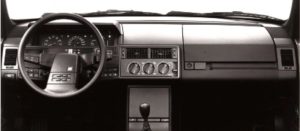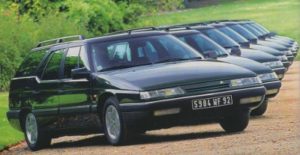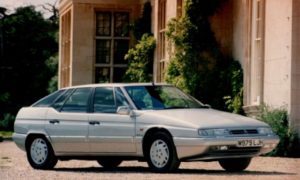Launched on 23rd May 1989, the XM replaced the CX in the executive car sector.

Designed by Bertone at a time when many buyers were complaining of car designs being imitative and boring, the XM presented a very different vehicle that Citroën aimed to be both sporting yet comfortable. To help achieve this aim, the well-known hydraulic suspension was developed a stage further with the introduction of Hydractive – adding a central ECU to control the firmness of the suspension, cutting down roll and sharpening the reactions to the steering, while keeping the ride quality good.
The XM was awarded European Car of the Year for 1990, following on from the success of its predecessor the CX which was Car of the year in 1974, and the smaller GS in 1971.

Initially, the XM was available with 2.0 8v carburettor or injected versions of the XU petrol engine, although the carb’d engine did not last long. There was also a V6 12v, making the XM the first Citroën with six cylinders since the SM. In diesel form, the XM was available with a 2.1 12v version of the XU, turbocharged or normally aspirated – although the non-turbo diesel never reached the UK. A few years into the XM’s life, first a 24v version of the V6 (short-lived due to oil feed problems to the head) then a turbocharged version of the 2.0 8v petrol were released.
Trim levels were base, S and SE, suffixed with i for injected petrols or d for diesels, with a handful of special editions at various times.
In 1991, the estate variant of the XM was launched. Like the CX, BX and Xantia estates, the XM estate’s production was contracted out to Heuliez.

For the 1995 Model year, the XM underwent a midlife re-style and face lift, now known as the ‘Series 2’. There were few changes to the exterior, with a new front bumper, door mirrors, a smaller boot spoiler, and a re-designed grille enabling the XM to fit in better with the contemporary corporate look. The most marked changes were the interior with a completely restyled dash board to coincide with the introduction of steering wheel airbags. At the same time some new engine variants were launched; the 2.0 8v Injection engine was replaced with a 2.0 16v injected engine. On the diesel front, a new 2.5 Turbo Diesel engine was launched to complement the 2.1 Turbo Diesel engine. At this time the trim levels were also changed to the SX, VSX and Exclusive levels common across the range. The original 12v V6 was replaced by a completely new 24v engine, mated to a high-tech ‘auto-adaptive’ switchable-mode automatic gearbox controlled electronically in conjunction with the engine’s ECU.

Unfortunately the XM was not the commercial success hoped for by Citroën, although 333 775 were produced between May 1989 and June 2000. The XMs reputation suffered badly from being launched before development work was completely finished; a long tradition with Citroën – early XMs suffered from severe electrical problems. However, most of these problems were ironed out after the first two years of production, and XMs after this time prove to be generally reliable cars. The XM restyle in 1994 didn’t re-launch the career of the XM, even though reliability improved further, and the dash was much more conservative.
Today the XM has a following of dedicated enthusiasts who appreciate the finer points of XM motoring. Values are on the up, and good cars are becoming increasingly difficult to find in the UK.


